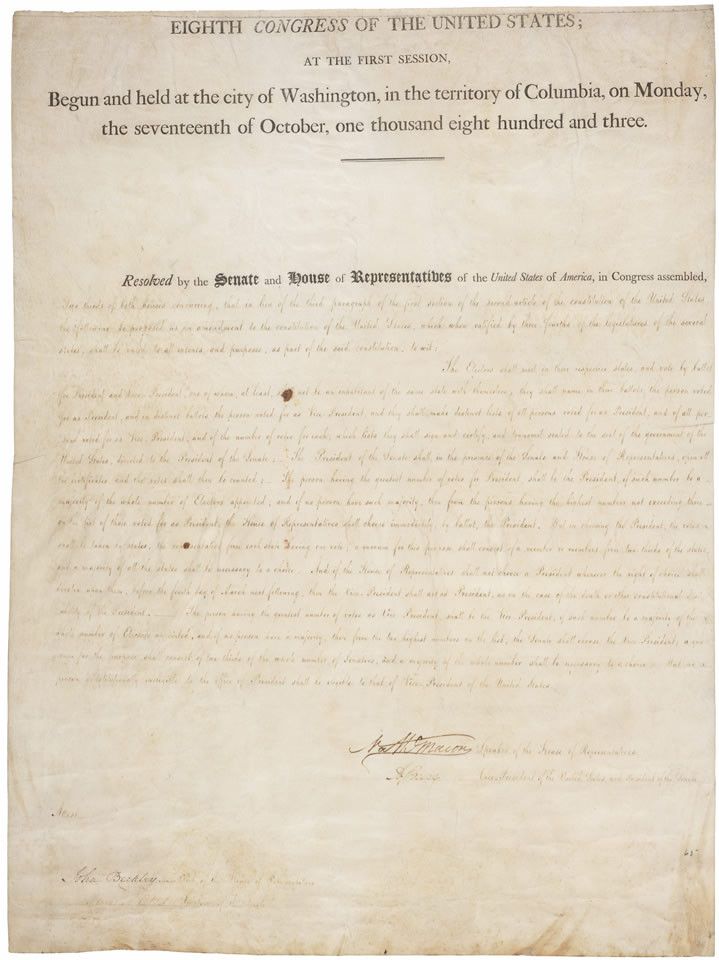Joint Resolution Proposing the Twelfth Amendment to the United States Constitution
12/9/1803
Add to Favorites:
Add all page(s) of this document to activity:

Ratified on June 15, 1804, the 12th Amendment modified the Electoral College, requiring separate Electoral College votes for President and Vice President. This would ensure that a tie vote could not happen again, like it had in the Presidential election of 1800.
Originally, the Constitution did not distinguish between President and Vice-President in the votes cast by each state's electors in the Electoral College. In the election of 1800, both Jefferson and his running mate Aaron Burr received 73 votes.
According to Article II, Section 1 of the Constitution, if two candidates each received a majority of the electoral votes but are tied, the House of Representatives would determine which one would be President. In 1800, the decision rested with the lame-duck, Federalist-controlled House of Representatives. Thirty-five ballots were cast over five days but neither candidate received a majority. Finally, on February 17, 1801, on the 36th ballot, the House elected Thomas Jefferson to be President.
Congress passed this joint resolution suggesting the 12th Amendment. A joint resolution is a formal opinion adopted by both houses of the legislative branch. A constitutional amendment must be passed as a joint resolution before it is sent to the states for ratification.
Originally, the Constitution did not distinguish between President and Vice-President in the votes cast by each state's electors in the Electoral College. In the election of 1800, both Jefferson and his running mate Aaron Burr received 73 votes.
According to Article II, Section 1 of the Constitution, if two candidates each received a majority of the electoral votes but are tied, the House of Representatives would determine which one would be President. In 1800, the decision rested with the lame-duck, Federalist-controlled House of Representatives. Thirty-five ballots were cast over five days but neither candidate received a majority. Finally, on February 17, 1801, on the 36th ballot, the House elected Thomas Jefferson to be President.
Congress passed this joint resolution suggesting the 12th Amendment. A joint resolution is a formal opinion adopted by both houses of the legislative branch. A constitutional amendment must be passed as a joint resolution before it is sent to the states for ratification.
Transcript
Eight Congress of the United States;At the First Session,
Begun and held at the city of Washington, in the territory of Columbia, on Monday, the seventeenth of October, one thousand eight hundred and three.
[horizontal line]
Resolved by the Senate and House of Representatives of the United States of America, in Congress assembled, two thirds of both houses concurring, that in lieu of the third paragraph of the first section of the second article of the constitution of the United States, the following be proposed as an amendment to the constitution of the United States, which when ratified by three fourths of the legislatures of the several states, shall be valid to all intents and purposes, as part of the said constitution, to wit:
The Electors shall meet in their respective states and vote by ballot for President and Vice-President, one of whom, at least, shall not be an inhabitant of the same state with themselves; they shall name in their ballots the person voted for as President, and in distinct ballots the person voted for as Vice-President, and they shall make distinct lists of all persons voted for as President, and of all persons voted for as Vice-President, and of the number of votes for each, which lists they shall sign and certify, and transmit sealed to the seat of the government of the United States, directed to the President of the Senate; -- the President of the Senate shall, in the presence of the Senate and House of Representatives, open all the certificates and the votes shall then be counted; -- The person having the greatest number of votes for President, shall be the President, if such number be a majority of the whole number of Electors appointed; and if no person have such majority, then from the persons having the highest numbers not exceeding three on the list of those voted for as President, the House of Representatives shall choose immediately, by ballot, the President. But in choosing the President, the votes shall be taken by states, the representation from each state having one vote; a quorum for this purpose shall consist of a member or members from two-thirds of the states, and a majority of all the states shall be necessary to a choice. The person having the greatest number of votes as Vice-President, shall be the Vice-President, if such number be a majority of the whole number of Electors appointed, and if no person have a majority, then from the two highest numbers on the list, the Senate shall choose the Vice-President; a quorum for the purpose shall consist of two-thirds of the whole number of Senators, and a majority of the whole number shall be necessary to a choice. But no person constitutionally ineligible to the office of President shall be eligible to that of Vice-President of the United States.
This primary source comes from the General Records of the United States Government.
National Archives Identifier: 1407979
Full Citation: Joint Resolution Proposing the Twelfth Amendment to the United States Constitution; 12/9/1803; Enrolled Acts and Resolutions of Congress, 1789 - 2013; General Records of the United States Government, Record Group 11; National Archives Building, Washington, DC. [Online Version, https://docsteach.org/documents/document/twelfth-amendment, April 23, 2024]Activities that use this document
- Flaws of the Electoral College System
Created by the National Archives Education Team
Rights: Public Domain, Free of Known Copyright Restrictions. Learn more on our privacy and legal page.



